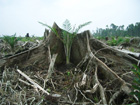 High-yielding oil palm crops meant to spare forests could in fact lead to an increase in deforestation, warn scientists. With the world’s population expected to expand to nine billion by 2050, ensuring we produce enough food whilst conserving biodiversity and protecting the environment is becoming a major challenge.
High-yielding oil palm crops meant to spare forests could in fact lead to an increase in deforestation, warn scientists. With the world’s population expected to expand to nine billion by 2050, ensuring we produce enough food whilst conserving biodiversity and protecting the environment is becoming a major challenge.
To stem expansion of agricultural land into areas of rainforest, experts have been focusing on increasing crop yields per hectare of land, to minimise the amount of land that is needed.
Increasing the yields of oil palm has become attractive as it already generates the highest yield of the world’s oil-producing crops. It is used in many products including cosmetics, and is a popular source of biofuel.
At first glance, increasing crop yields seems like positive news for forest conservation. But, writing in the journal Science, scientists at Imperial College London, National University of Singapore and the University of Sheffield are concerned that as global demand increases, more countries may begin to replace existing tropical forest with high-yielding crops.
South East Asia is currently the main region for oil palm production. As yields continue to improve and market prices drop, scientists are warning against opening the door to massive production of oil palm in Africa and Latin America.
In these regions, land that would be suitable for oil palm is currently covered by tropical forests. And suitable temperatures and rainfall in these areas could see farmers more than doubling their crop production. Researchers fear that increased global deforestation will be the likely outcome if companies start to move production of high-yielding oil palm to Africa and Latin America.


